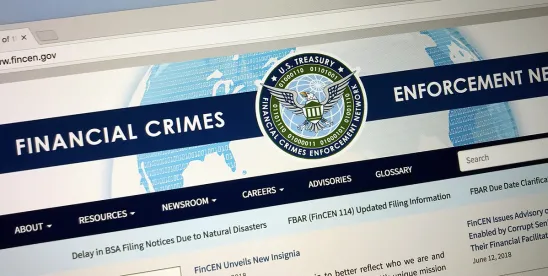On August 28, 2024, the U.S. Department of the Treasury’s Financial Crimes Enforcement Network (“FinCEN”) issued two final rules to counter financial crime and safeguard national security: one broadening the definition of “financial institution” to include certain registered investment advisers (“RIAs”) and exempt reporting advisers (“ERAs”) under the Bank Secrecy Act (“BSA”), and one mandating FinCEN reporting on certain residential real property transfers.
As outlined in more detail below, RIAs and ERAs will need to reevaluate their anti-money laundering (“AML”) risks and revise their compliance programs accordingly as additional scrutiny will be placed upon certain transactions. Real estate experts should also ensure that their clients are in compliance with the new rules.
The Final Investment Adviser Rule
Background
FinCEN proposed regulations imposing comprehensive BSA/AML compliance obligations on investment advisers in 2003 but withdrew them in 2008. It was clear during the years that followed, however, that there was regulatory intent to capture these types of entities under the BSA/AML regulatory regime.
In February 2024, the U.S. Department of the Treasury published a risk assessment tailored to the investment adviser sector (“2024 Assessment”), building on the 2022 National Money Laundering Risk Assessment, that highlighted where sanctioned persons and other bad actors were taking advantage of the U.S. investment adviser industry to facilitate illicit activity, including tax evasion and fraud, and compromise national security interests. The 2024 Assessment identified the People’s Republic of China and the Russian Federation as the chief culprits among foreign states, using investment advisers to buy into early-stage companies and access technology and related services that would eventually create national security exposure for the United States.
Definition of Financial Institution
The new Final Investment Adviser Rule mitigates the money laundering risks and national security concerns identified by the U.S. Department of the Treasury by extending the definition of a “financial institution” under the BSA to “investment advisers,” including RIAs and ERAs, which previously did not have comprehensive AML program requirements.
Now, RIAs and ERAs must generally comply with the full suite of BSA program, reporting and recordkeeping requirements, with some exceptions. The proposed rule would have included all RIAs and ERAs in the definition of “investment adviser,” but in response to comments that expressed concern about the burdens imposed on smaller firms, FinCEN narrowed the definition to exclude: (i) mid-sized advisers, as defined in Section 203A(a)(2)(B) of the Investment Advisers Act (“IAA”); (ii) pension consultants, as defined under 17 C.F.R. § 275-203A-2(a); (iii) multi-state advisers, as defined under 17 C.F.R. § 275-203A-2(d); (iv) investment advisers that do not report any assets under management on their Form ADV; and (v) state-registered advisers.[1]
The Final Investment Adviser Rule further addresses concerns raised in comments about the applicability of the proposed rule to RIAs or ERAs based outside of the United States. For these investment advisers, defined as “foreign-located investment advisers,” who have a principal office and place of business outside the United States, the Final Investment Adviser Rule applies only to advisory activities that (i) take place within the United States, including through the involvement of U.S. personnel of the investment adviser or (ii) provide advisory services to a U.S. person or a foreign-located private fund with an investor who is a U.S. person.
The BSA Requirements and Implementation Timeline
The Final Investment Adviser Rule mandates that RIAs and ERAs implement a comprehensive written AML compliance program by January 1, 2026. This program must encompass the following essential elements:
- Internal Controls: RIAs and ERAs must create policies and procedures outlining internal controls to prevent the firm from being used for illicit activities like money laundering, terrorist financing, and other financial crimes.
- AML Officers: RIAs and ERAs must designate at least one qualified AML compliance officer to oversee the program.
- Training: RIAs and ERAs must provide AML training for relevant personnel.
- Independent Testing: RIAs and ERAs must conduct independent assessments of their AML compliance program’s effectiveness.
- Customer Due Diligence: RIAs and ERAs must implement risk-based procedures so that firms understand customer relationships, are able to create a customer risk profile, continually monitor customers for red flags, and regularly update customer information based on risk assessments.
It is expected that some RIAs and ERAs have already implemented AML programs of their own volition, but it is advisable for these firms to review the Final Investment Adviser Rule to ensure that their programs align with FinCEN’s commentary and minimum requirements, including:
- Suspicious Activity Report (“SAR”) Filings: RIAs and ERAs will be required to report suspicious activity to FinCEN. SARs must be filed when a transaction involves or aggregates funds or assets of $5,000 or more, and the RIA or ERA knows that the transaction or group of transactions either:
- Involves illicit funds (the proceeds of the transaction stem from illegal activities or hide/ disguise the source of illegal funds);
- Evades reporting (intentionally avoids BSA reporting requirements);
- Lacks legitimate purpose (has no reasonable business rationale or is unusual for the customer); or
- Facilitates crime (the transaction uses the RIA or ERA to aid in criminal activity).
- Independent Testing: The Final Investment Adviser Rule mandates that RIAs and ERAs conduct independent testing of their AML programs. Firms have the option to test internally or externally. If using internal testers, they must be completely independent from the AML program, and cannot be involved in its implementation or report to someone who implements the program. Though costly, external testing is likely to be the most risk-averse and more practical option.
- Know Your Customer (“KYC”) and Customer Due Diligence Rules: Notably, the Final Investment Adviser Rule does not mandate that RIAs and ERAs establish Customer Identification Programs, but FinCEN published a proposed rule on May 13, 2024, that would require RIAs and ERAs to establish, document and maintain programs for KYC due diligence.[2]
Each RIA and ERA must tailor its program to its own unique business structure and risk profile.
Although FinCEN maintained the proposed rule’s exclusion of mutual funds from an investment adviser’s BSA/AML obligations, commenters during the notice and comment period expressed concerns that this would make an RIA or ERA responsible for ensuring that mutual funds were compliant with their individual AML/CFT program obligations. As a result, the Final Investment Adviser Rule clarified that investment advisers would not have to verify that a mutual fund had implemented an appropriate AML/CFT program. Similarly, commenters pointed out that banks and trust companies that sponsor and act as trustees of a collective investment fund are already subject to AML/CFT reporting obligations under the BSA, and FinCEN agreed. Thus, an investment adviser may also exclude bank- and trust company-sponsored collective investment funds and any other investment adviser subject to the final rule that is advised by the investment adviser.
Application
The Final Investment Adviser Rule will not go into force until January 1, 2026. While this gives RIAs and ERAs more than a year to implement AML programs that conform to the new requirements, these programs will begin to face increased scrutiny from regulators and should not delay in enhancing their AML compliance infrastructure.
The Final Real Estate Rule
Background
To combat money laundering through residential real estate, on August 28, 2024, FinCEN published a final rule (the “Final Real Estate Rule”), which mandates reporting requirements for certain property transfers. FinCEN found that the real estate market presents vulnerabilities that allow illicit actors, often operating through shell companies, to exploit non-financed transactions (e.g., “all-cash” sales) to place the proceeds of illicit activity into a legitimate economy without detection. By imposing reporting obligations on these transfers, the government aims to prevent anonymous laundering of illicit proceeds through real estate purchases. This rule expands on FinCEN’s Residential Real Estate Geographic Targeting Orders (“GTOs”), which previously required title insurance companies to report beneficial owners for certain non-financed purchases in specific jurisdictions. The Final Real Estate Rule implements a broader regulatory measure that intends to stop illicit use of the U.S. residential real estate market. Real estate professionals should pay special attention to this rule, including those who deal in commercial real estate as FinCEN has indicated that it may issue another rule targeting this segment of the real estate market.
Reportable Transfers of Residential Real Property
The Final Real Estate Rule requires “reporting persons” involved in certain eligible transfers of residential real estate to submit details about the parties involved and the property itself to FinCEN through a “Real Estate Report.”
Transfers are reportable if the following four criteria are met:
- Residential. The property is residential real property, defined to include single-family houses, townhouses, condominiums, and cooperatives, including condominiums and cooperatives in large buildings containing many such units, and entire apartment buildings designed for occupancy by one to four families; transfers of land, including vacant and unimproved land on which the transferee intends to build a structure designed for occupancy for one to four families; and mixed-use property, such as a single-family residence located above a commercial enterprise.
- Non-Financed. The transfer is non-financed, meaning that there has been no credit extension or loan secured by the property, or the lender is not subject to AML regulations and SAR requirements. Transfers financed by a lender without AML obligations, such as a non-bank private lender, are treated as non-financed and may be reportable.
- Transferee Entity or Trust. The property is transferred to a “transferee entity” or “transferee trust.” This includes common property ownership vehicles like limited liability companies, corporations, partnerships, and trusts, both domestic and foreign. Certain exemptions apply to highly regulated entities and trusts that are less likely to be used for money laundering through real estate.
- Non-Exempt. None of the applicable exemptions exist. These exemptions include easements, transfers upon death or divorce, transfers to bankruptcy estates or court-supervised transfers, transfers by individuals to trusts they control, and transfers where no reporting persons are involved, among others.
All reportable transfers must be reported, regardless of purchase price or property value, including gift transfers. However, direct transfers to individuals are not covered by the rule.
Reporting Persons
Only one person is required to file the Real Estate Report for each reportable transaction. This reporting person must be a professional or their employee involved in the transfer. The “reporting cascade” determines who must file the report, in order of priority: (1) settlement or closing agent; (2) preparer of settlement or closing statement; (3) filer of deeds or other transferring instruments; (4) title insurance underwriter; (5) distributor of transfer funds; (6) title evaluator; or (7) preparer of deeds or other instruments of transfer. If none of these individuals are involved in the transfer, a report is not required.
Alternatively, transaction participants can agree on a specific reporting person through a written agreement. Notably, lawyers are not exempted from the definition of reporting persons, should they be involved in a reportable real estate transaction.
The Real Estate Report
The Final Real Estate Rule requires reporting persons to provide the following information:
- The reporting person’s identity;
- The transferee entity or trust;
- The beneficial owners[3] of the transferee entity or trust;
- The individuals signing documents on behalf of the transferee entity or trust;
- The transferor;
- The residential real property being transferred; and
- The total amount of consideration and payment information.
The Real Estate Report must be filed by the last day of the month following the month of the reportable transfer or within 30 calendar days of closing, whichever is later. While the reporting person does not need to retain a copy of the report, they must keep a copy of any certification of beneficial ownership information signed by the transferee or their representative, along with any designation agreement, for five years.
FinCEN indicated it will likely publish the report form in 2025.
Application
The Real Estate Rule goes into effect on December 1, 2025. Non-compliance with the rule could result in significant civil and criminal penalties, including potential imprisonment. Reputational risk is also as stake, as a breach or alleged breach of the BSA can have a severe impact on an institution’s business.
Our firm’s white-collar team specializes in implementing complex regulations like the Final Investment Adviser Rule and the Final Real Estate Rule. Our experts, including former FinCEN employees, can provide guidance and answer questions as clients navigate the implementation of these new rules over the next year.
[1] FinCEN noted in the preamble of the Final Investment Adviser Rule that given the risk of money laundering, terrorist financing, and other illicit finance activity is generally lower for state-registered advisers, the rule will not apply to state-registered advisers at this time. However, FinCEN will continue to monitor activity by state-registered advisers and may take steps in the future to mitigate illegal activity.
[2] https://www.fincen.gov/news/news-releases/sec-fincen-propose-customer-identification-program-requirements-registered
[3] Beneficial owners of transferee entities are individuals who exercise substantial control directly or indirectly, or own or control at least 25% of ownership interests. This definition aligns with FinCEN’s Beneficial Ownership Information Reporting Rule. Beneficial owners of transferee trusts are individuals who are trustees or have authority over trust assets, are sole permissible recipients of income and principal, are grantors or settlers of revocable trusts or own or control an entity or trust holding one of these positions.





 />i
/>i
